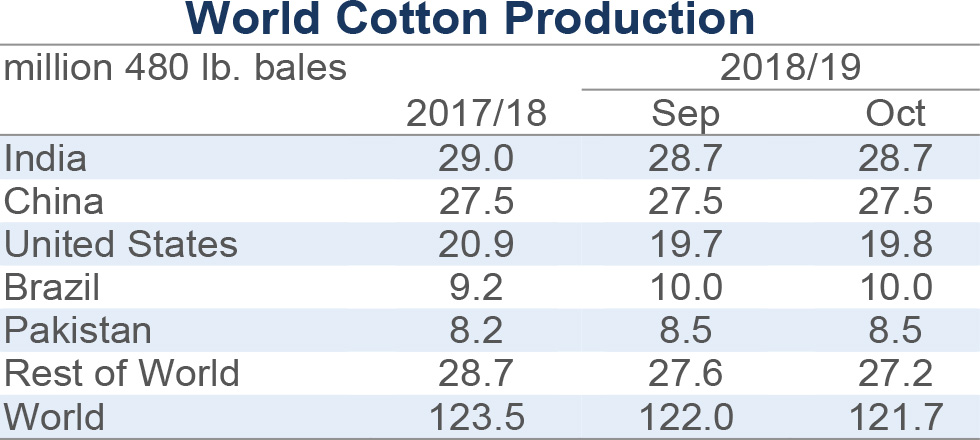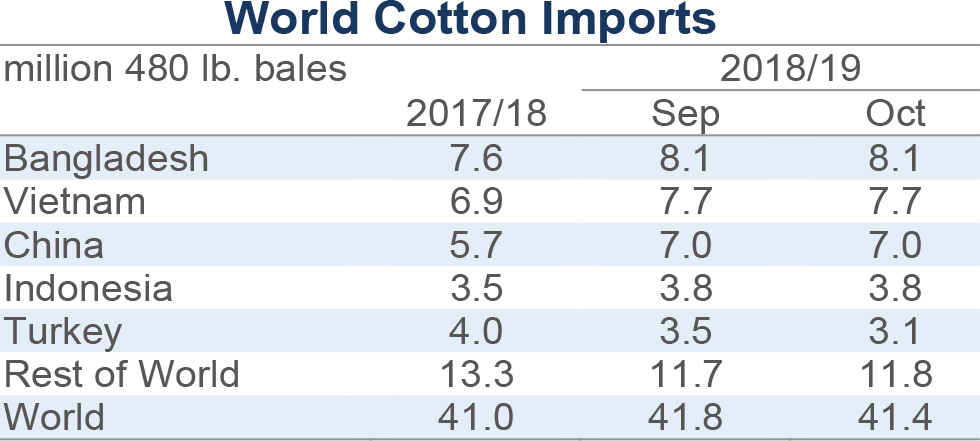Monthly Cotton Economic Letter (2018.10)
Oct 29, 2018 | by

Recent price movement
Most benchmark prices decreased over the past month. Chinese prices were stable.
l Values for the December NY futures contract moved lower in the second half of September, dropping from 82 to 76 cents/lb by early October. In later trading, prices have generally held between 76 and 78 cents/lb.
l The A Index also moved lower in the second half of September. Losses pulled the A Index from 92 to 86 cents/lb.
l The Chinese Cotton Index (CC Index 3128B) fell in both domestic and international terms over the past month. In domestic terms, the CC Index decreased from 16,300 to 16,000 RMB/ton. A decline in the RMB relative to the dollar (-1% over the month) amplified decreases in dollar terms, with values falling from 108 to 105 cents/lb.
l Indian spot prices (Shankar-6 quality) decreased in local terms, falling from values above 47,700 to 46,500 INR/candy. The Indian rupee (INR) also lost ground against the dollar over the past month (-3% over the month). This put additional downward pressure on values expressed in USD, with Indian benchmark prices falling from 84 to 80 cents/lb.
l Pakistani spot prices moved lower from mid-September through early October (from 8,300 to 7,650 PKR/maund). More recently, however, prices turned higher (rising to 8,400 PKR/maund). A drop in the value of the Pakistani rupee (PKR) offset the effect of these recent advances (-8% over the month). Pakistani benchmark values are lower than one month ago in USD terms (81 cents/lb in mid-September, 76 cents/lb currently).
Supply, demand, & trade
This month’s USDA report included slight downward revisions to world production and mill-use figures. The global harvest number was lowered 314,000 bales (from 122.0 to 121.7 million) and the global consumption number was lowered 184,000 bales (from 127.9 to 127.8 million).
Much larger changes were made to historic figures for Indian stocks. These revisions extended back to the 2002/03 crop year and reduced the persistent discrepancy between estimates from domestic Indian organizations and those from the USDA. However, a wide separation remains. The current 2017/18 ending stock estimate from the Cotton Association of India is 1.8 million bales (no published figure for 2018/19 yet, crop year ending in September). The current USDA estimate for 2017/18 ending stocks is 9.0 million bales (crop year ending in July). USDA updates were centered on stock levels (i.e., they involved comparatively minor revisions to production and use estimates over the same time period) and resulted in estimates for Indian 2018/19 beginning and ending stocks that are 2.9 million bales lower than last month (9.0 currently, 11.9 last month).
With the changes to global production and consumption numbers small, these revisions were the factor that drove global 2018/19 beginning stocks down 2.9 million bales and global 2018/19 ending stocks down by 3.0 million bales. Likewise, these changes had a large effect on projected world-less-China ending stocks, which also fell 3.0 million bales month-over-month. Nonetheless, with Indian stocks in previous years being lowered, the current prediction for world-less-China stocks in 2018/19 still calls for a new record this crop year (44.6 million bales, exceeding 42.9 million in 2017/18 by 1.7 million). The corresponding decrease in the world-less-China stocks-to-use ratio, however, resulted in a figure below the record. The current value of 48.3% is lower than the figure from 2017/18 (48.7%) and lower than those commonly posted ahead of the 2010/11 price spike.
At the country-level, the largest revisions to production figures included those for Australia (-500,000, to 2.5 million), Greece (+100,000, to 1.4 million), and the U.S. (+81,000, to 19.8 million). The only notable revision for mill-use was for Turkey (-200,000, to 7.3 million).
Global trade forecasts were lowered 353,000 bales (from 41.8 to 41.4 million). The only notable country-level revision to import figures was for Turkey (-400,000 bales, to 3.1 million). The largest export revisions included those for Australia (-300,000 bales, to 3.6 million), the U.S. (-200,000, to 15.5 million), and Brazil (-100,000, to 5.4 million).
Price outlook
For the second time in one month, a major hurricane struck the southeastern region of the U.S. cotton belt. The latest storm, Hurricane Michael, is a bigger threat to U.S. production. This is because the storm is stronger, it covered more cotton acreage, and the acres in its path have a higher percentage of bolls open (fiber more vulnerable). Georgia, which was directly in Michael’s path, was forecast to represent 15% of U.S. production this season (2.9 million bales). About 90% of Georgian acres had bolls open when the storm hit and only about 15-20% had been harvested. Production in Florida (0.2 million bales), Alabama (1.1 million bales), and the Carolinas (1.2 million bales) may also be affected.
While the weather poses questions to the supply side of the U.S. balance sheet, greater uncertainty likely exists on the demand side. Driving much of this uncertainty is the escalating trade dispute between the U.S. and China. On September 24, a new round of tariff increases went into effect on both sides. For the U.S., a list of Chinese goods valued at $200 billion was hit with a 10 percentage point (ppt) increase in duty rates (scheduled to rise another 15 ppt on January 1st). This list included most of Harmonized System (HS, global standard for import/export classification) Chapters 50-60. These chapters cover fiber, yarn, and fabric. HS Chapters 61-63, which cover finished apparel and home furnishings (e.g., sheets, towels, bedding) were excluded from the $200 billion list.
The latest set of Chinese tariff increases covered a list of U.S. goods valued at $60 billion. These goods were hit with 5 or 10 percentage point increases in duty rates. Following this round, essentially all U.S. exports to China have been subjected to tariff increases.
In reaction to the latest set of Chinese increases, the U.S. promised to impose tariffs on essentially the remainder of its imports from China ($267 billion list of goods). It is currently unknown when this might go into effect and what the rate of increase might be, but HS Chapters 61-63 can be expected to be included. Given that the U.S. imports the vast majority of the apparel and home furnishings sold at retail, and that China has a dominant share of U.S. apparel and home furnishing imports (about 40% of apparel imports, about 30% of home furnishing imports), these tariff increases could lead to higher U.S. consumer prices for finished textile goods. A consequence of higher retail prices could be reduced consumer demand.
Other consequences may be surfacing in the fiber trade. Since the early summer, Chinese mills appeared to have adopted a wait-and-see approach relative to tariffs. In the past few weeks, however, cancellations began to materialize. The extent to which China might turn away from the U.S. as a source of supply could be expected to complicate trade patterns globally. The prospect of higher Chinese import demand resulting from lower Chinese reserve stocks, as well as smaller crops from alternative exporters like Australia, add to the complexity.








